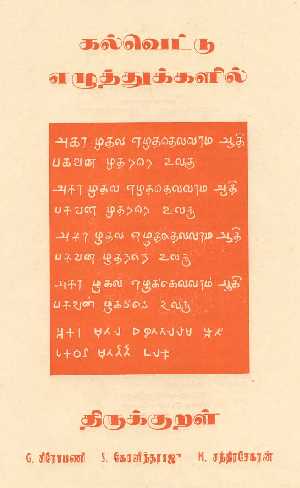
Home | Biodata | Biography | Photo Gallery | Publications | Tributes
Epigraphy

 |
Home | Biodata | Biography | Photo Gallery | Publications | Tributes Epigraphy |
 |
Though Tamilnadu is full of interesting antiquities, very few laymen develop an interest in their study. For instance, there are any number of old temples with Tamil inscriptions, but hardly anyone shows an interest in reading these inscriptions, though they are usually not very difficult to decipher.
However, a small band of students of the Madras Christian College is now going round Tambaram and the surrounding villages, taking estampages of inscriptions and reading them.
At Pammal, on the basement of a ruined Siva temple, two Chola inscriptions not heretofore noticed were copied by the students. One is dated in the reign of Tribhuvanachakravarti Sri Rajarajadeva, and the other, in the reign of Virarajendra.
The inscription of the time of Rajaraja (III) is incomplete. It refers to an endowment for burning a lamp at a temple at Pammal. The inscription mentions that the village of Pammal belonged to Surathurnadu. It may be interesting to note that Surathurnadu was a territorial division probably named after Tiruchuram. Tiruchuram happens to be the old name of the apsidal Chola temple near Pallavaram, which is now called Tirusulam.
The second inscription at Pammal is dated in the 35th year of the reign of Virarajendra Chola. If Virarajendra is Rajendra III, the king who succeeded Rajaraja III, then this is probably the latest reported inscription of the reign of Rajendra III.
The inscription is complete and refers to an endowment of land by Panchanadhivaanan Nilakangarayan and to its exemption from taxes. The endowment is made to the temple of Azhaga Perumal by the Sri Vaishnavas.
Of special interest was the fact that this inscription refers to Tambaram, which is also called Gunaseelanallur. Tambaram is referred to here as Taampuram. Or perhaps it should be read as Taamapuram, or even Dharmapuram, because these three different forms would be written in precisely the same way in the ancient Chola Tamil script.
Another village visited by the students was Perungalatur, which is about a mile from the Standard Motor factory which is just south of Tambaram. In regard to the name of Perungalatur, the word 'kalam' in Tamil could mean either a battlefield or a threshing 'floor' of a paddy field. One might be tempted to derive the name from some great battle fought here in days gone by, since Perungalatur is quite near to Manimangalam where Narasimha I Pallava defeated the Chalukyan king, Pulakesi II.
However, a newly discovered Chola inscription on the basement of the Ahatisvara temple in Perungalatur gives the old name of the village as Perunkulatur, that is, the village of the big tank.
On this temple there are three incomplete inscriptions dated in the reign of Raja Raja III. Two of the inscriptions refer to the endowment of a single cow for burning a perpetual lamp in the temple. According to the inscriptions, the village belonged to Nedungunra nadu. Nedungunram is now a small village east of the Standard factory.
Vandalur was another place visited. It has been surmised that Vandalur was the ancient Vandainagar of the Chola kings referred to in "Kalingatuparani". However, from a late inscription of the 17th century on a small apsidal temple at Vandalur, we find that the old name of the village was Vendalur. The inscription confirms an earlier grant of land for the daily worship and the burning of a perpetual lamp.
Even the little village of Selaiyur, adjoining Tambaram, can boast of inscriptions. In one of these, the village is referred to as Seylayur, and not Solaiyur or Silayur, as has sometimes been suggested.